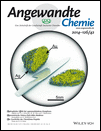A Layered Hybrid Perovskite Solar-Cell Absorber with Enhanced Moisture Stability†
This research was funded by the Global Climate and Energy Project. X-ray diffraction studies were performed at the Stanford Nanocharacterization Laboratory. We thank William Nguyen and Greyson Christoforo for experimental assistance.
Abstract
Two-dimensional hybrid perovskites are used as absorbers in solar cells. Our first-generation devices containing (PEA)2(MA)2[Pb3I10] (1; PEA=C6H5(CH2)2NH3+, MA=CH3NH3+) show an open-circuit voltage of 1.18 V and a power conversion efficiency of 4.73 %. The layered structure allows for high-quality films to be deposited through spin coating and high-temperature annealing is not required for device fabrication. The 3D perovskite (MA)[PbI3] (2) has recently been identified as a promising absorber for solar cells. However, its instability to moisture requires anhydrous processing and operating conditions. Films of 1 are more moisture resistant than films of 2 and devices containing 1 can be fabricated under ambient humidity levels. The larger bandgap of the 2D structure is also suitable as the higher bandgap absorber in a dual-absorber tandem device. Compared to 2, the layered perovskite structure may offer greater tunability at the molecular level for material optimization.




